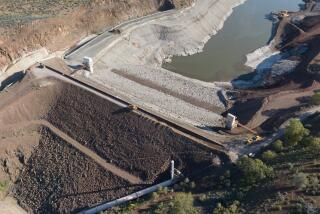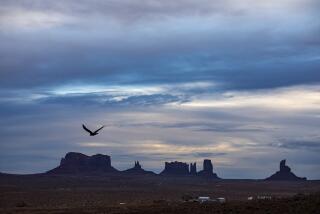Tribe That Time Forgot Faces Dam, Doom
- Share via
EPUPA FALLS, Namibia — In this harsh corner of southwestern Africa live black people with white feet.
Shimmering heat and an unrelenting sun conspire to parch earth and rock, creating a choking dust that coats all the eye can see, including the feet of the Himba.
A tribe of several thousand herders, the Himba exist as their ancestors did on the barren plains around the Cunene River. Every meager resource goes toward survival, from their huts made of cow dung to the paste of boiled butter and ground ocher that shields their skin.
Approaching through the scorched scrub, their legs enveloped in chalky billows, they seem to grow right out of the bleached soil.
Now their way of life faces a new threat. The government plans to dam the Cunene and flood the tribe’s grazing fields and some ancestral graves. The Himba say they will not be moved.
“We will just sit here,” insisted tribal leader Hikuminue Kapika, waving a stick, then dropping it with a flourish. “And they will have to build on top of us.”
*
So pastoral that they don’t know how old they are, or how many, the Himba scratch out an existence in a cruelly beautiful pastel landscape of sand, rock and sky.
They cook over fires, sleep on the ground and walk everywhere unless they can hitch a ride. Their birthright and legacy are their land and herds of cattle and goats.
Through decades of South African colonial rule and Namibia’s 23-year bush war for independence, Himba territory in northwest Namibia and southwest Angola was isolated and tightly regulated.
With independence in 1990, it opened up to traders, tourists and anthropologists. But no one was interested until the government, short of foreign investment and electric power, determined that the deep gorge along the Cunene cut by Epupa Falls made an ideal location for a dam.
The idea dates back 60 years but has taken on renewed urgency because Namibia, which imports its energy, has a growing population that swells cities and requires new development.
“We desperately need power,” said Imker Hoogenhout, senior general manager for technical services at NamPower, the state electric company.
The dam would submerge Epupa Falls and the surrounding valley. Grazing fields and river foliage such as palm nuts prized as food during drought would disappear, along with ancestral Himba graves.
Although construction is at least two years off while NamPower negotiates with neighboring Angola and raises the $800 million needed, Hoogenhout conceded that the end result was obvious, even with financial compensation or new land for the Himba.
“I’m of the opinion the Himba are doomed,” he said in Windhoek, 620 miles to the south. “This project will just speed it up.”
Kapika, the Himba headman, also believes the dam means doom.
Life is tough enough without it, he said beneath a shade tree outside his kraal, or homestead, about 18 miles from thundering Epupa Falls.
A short, lean man with slitted eyes and large hands callused by years of labor, he wore a cloth apron, brown knit cap and no shirt.
As headman of at least 1,500 Himba in the Epupa region that straddles the border with Angola, Kapika recited a litany of problems.
Wells dug by the South Africans are dry, and the government doesn’t fix them. Food from aid agencies comes sporadically. The nearest clinic, 44 miles away, rarely has a doctor or nurse on duty.
Asked about the proposed dam, he delivered a staccato tirade.
“They want to take our land, Epupa, where we buried our forefathers,” he began, speaking through an interpreter. “They are suggesting that we remove the graves. I have refused. . . .
“The previous government, the one of the whites, they used to support the people very well. This one of the blacks, it is killing us.”
The Himba plant corn near the Cunene, take water from it and preserve fields where their herds graze in hard times, he said, waving his arm broadly.
“There is no place along this river that is bad for us. All of it is good,” he said. “That’s why we are saying we are not going to kill our kingdom. We are not going to kill those things by putting them under the water or under the dam.”
President Sam Nujoma made a rare visit this year and talked with Kapika about his troubles, but neither man mentioned the dam project. Did Kapika think Nujoma’s visit would help?
“Don’t ask stupid questions,” he spat. “I told you that we never get help with boreholes [wells] and other things. We never get help. Now, how do you expect me to believe him?”
*
While the Himba complain of their freedom being trampled, they are among the most rigidly ordered people on Earth. From birth until death, maternal and paternal lineage determine where they stay, which land they inherit and which herds they own. They dress and wear their hair in prescribed styles befitting their development-- pre-pubescent girls have two short braids, boys a lone Mohawk-style plait.
Time is measured by the sun. Goats go to graze after dawn and come back as the sun starts to descend. Water is gathered closer to the coolness of dusk, easing the ordeal of carrying it back in a 7-gallon drum balanced on the head.
Periodic drought forces the Himba to save some prime fields for use in emergency. Men graze the cattle herds, their symbols of wealth, for days and even weeks, setting up temporary shelter far from the main kraal.
Back home, women do most of the work. Margaret Jacobsohn, an anthropologist who studied the Himba, lists 24 regular tasks for women and seven for men.
Himba women are bare-breasted and coat themselves in ocher grease from head to toe. Copper bangles adorn wrists and neck.
Inside a cow-dung hut, Muhapikua sat in the dust grinding corn with a rock, her hands performing with machine-like precision. Pregnant with her first child, she said she sought nothing more than to live a traditional life--without any dam projects.
“I don’t want to be alone, lonely,” she sighed. “The people here in this kraal, I like them very much. I like to be here with them because I don’t like to be alone.”
But other young Himba want more. At a small shop near the falls, ocher-smeared Himba girls flirted with boys of another tribe, the Herero, dressed in Western-style clothing. On a Friday night, with music blaring and beer flowing, some Himba girls go to dance.
Maipi, a muscular young man wearing the traditional apron and a necklace of shell and leather, spoke of customary aspirations--with one catch.
“I just want to accumulate more goats, many livestock, until I have enough to buy a car,” he said.
Kapika, told of Maipi’s wish, reacted acidly.
“You’re talking of a young child,” he said. “If he wants to buy a car, then he is out of order. Then he will start to wear clothes. . . .
“It’s always like that. When a Himba turns to wear clothes, his mind is getting confused.”
Such resistance didn’t prevent Kapika from cadging a ride to town with journalists in their pickup. He sat in the front, on a tarpaulin stretched over the seat to protect it from his body grease.
At one point he tapped the driver’s wrist to stop the vehicle, then scavenged an empty cardboard box lying on the ground.
*
At a public meeting last year, Kapika led a delegation of Himba who complained that they were never consulted about the dam.
A feasibility study by a consortium of Scandinavian and Namibian groups acknowledged its findings were incomplete because it lacked input from the Himba due to a breakdown in communication between the tribe and the government.
In response, the government has asked the University of Namibia to start talks with the Himba on reparations, including the possibility of a nature reserve where wildlife and tourism would be controlled by the Himba.
But Maipi, the young man who dreams of a car, said that wouldn’t matter.
“We must resist” the dam proposal, he declared, then laughed aloud when asked if the Himba would fight.
“We will fight with our mouths. We don’t have the weapons to fight a war,” he answered. “Yes, we are going to stay. . . . This is our house, our home. If it is closed, then we are dead.”
More to Read
Sign up for Essential California
The most important California stories and recommendations in your inbox every morning.
You may occasionally receive promotional content from the Los Angeles Times.













